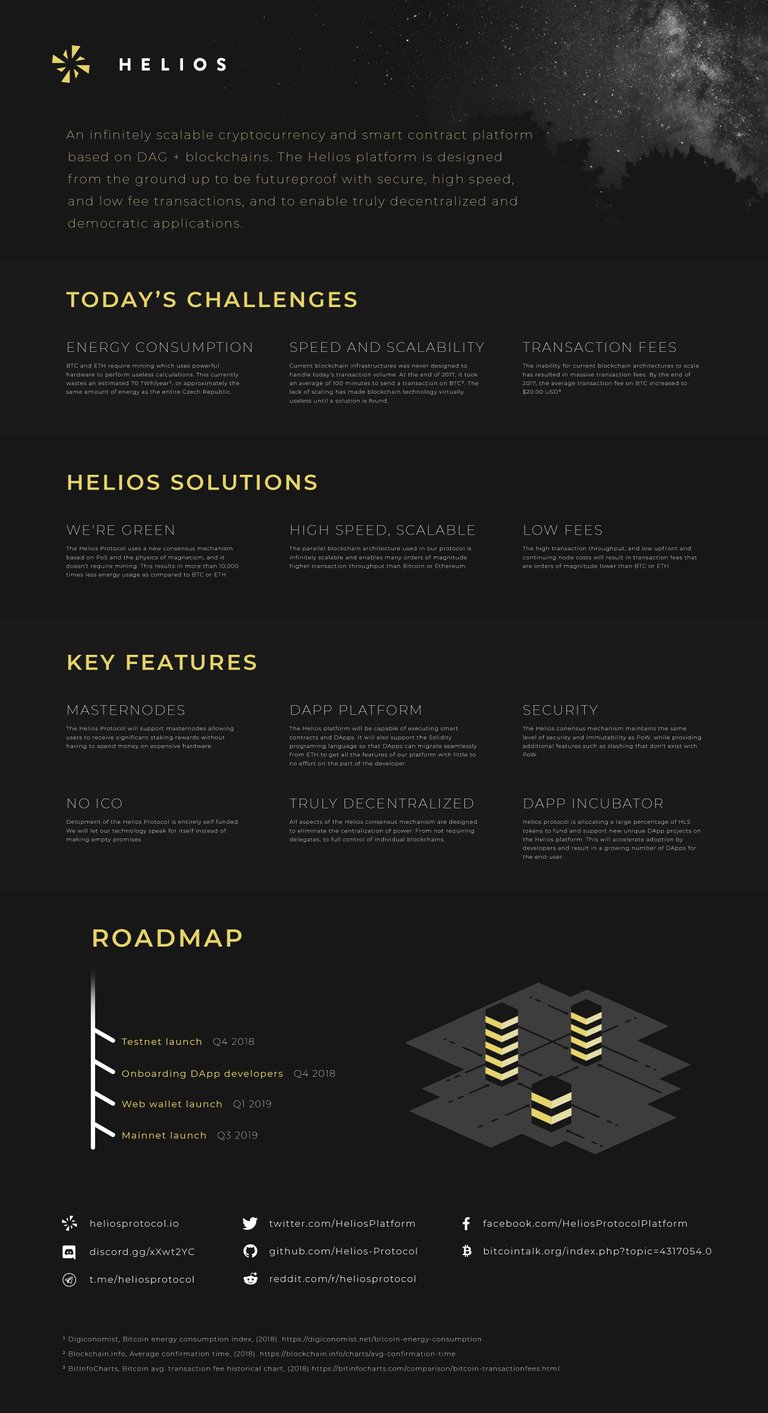Come up with an idea for a DApp on the Helios Platform, write about it, and get up to 2500 HLS! https://twitter.com/HeliosPlatform
An infinitely scalable cryptocurrency and smart contract platform based on DAG + blockchains. The Helios platform is designed from the ground up to be futureproof with secure, high speed, and low fee transactions, and to enable truly decentralized and democratic applications.The Tech
Helios Protocol’s blockchain has a lot of exciting new features it plans to implement into its flavor of blockchain. The main types of consensus protocols among blockchains are currently are Proof-of-Work(PoW), Proof-of-Stake(PoS), and Directed Acyclic Graph(DAG). Helios Protocol is a combination of a DAG ledger based blockchain that is using PoS as it’s consensus mechanism. Each wallet has its own blockchain that is completely unique to that specific wallet which is a feature specific to a DAG blockchain. The PoS consensus mechanism is used to secure the blockchain and keep all nodes in consensus. This becomes clearer as to why as we break down the tech some more.
Blockchain design
The blockchain design of the Helios Protocol differs from that of Bitcoin and Ethereum in that there is not one single blockchain ledger that gets sequentially added to and propagated across all active participants. In the Helios Protocol, each wallet has its own blockchain and each wallet is responsible for writing those transactions to its own blockchain. The only entries in a wallet’s blockchain are the send and receive transactions to and from it. The only users who are responsible for having these transactions in their blockchains are the users who are involved. This drastically cuts down on the network demand of the Helios Protocol compared to other blockchains as every single transaction is not required to be communicated to every participant of the blockchain. This also allows the blockchain to grow indefinitely as each new wallet/user in the Helios Protocol adds to the total transactions per second speed.
Full nodes and masternodes -yes masternodes- are responsible for replicating the entire blockchain database, which includes all user blockchains. Full nodes are nodes that have decided to sync the entire database to participate in the Helios Protocol and masternodes are full nodes that stake a certain amount of coins to secure the network. Every wallet’s blockchain that is created will be synced to these full nodes allowing the wallet owner to sync their blockchain wherever they access it. The wallet blockchain is also very small and should be less than 1Mb in size.
Consensus
Consensus on the Helios Protocol is a bit confusing to me so I will try to sum it up the best I know how. All nodes participating in the network have a certain magnetic pull for instance. The network wants to all face the same direction, or have consensus, so by basing the strength of the nodes magnetism on their amount staked, the strongest will always win. In blockchain, the strongest will always be the correct path in which the majority of nodes are in agreement on. This means that if one node had 49% stake, but the other nodes had 51% stake, the node with the smaller stake would always lose due to the rules written into the blockchain.
Distance also takes a priority in consensus here. Think of each 100 nodes placed around the world. Two nodes in Asia would look to each other for consensus and not to a node in South America for consensus due to network latency (time of round trip communication to occur). So if one node in South America decides to go against consensus, the majority of nodes staked in Asia would be less affected by that single node far away, and would still have consensus with their closer neighbors in alignment.
Security
The Helios Protocol is using slashing as a means to secure the network, on top of the consensus protocol explained in the above section. Slashing is a way of taking away funds from a user who abuses the blockchain rules. There will be cases where a wallet makes a bad block and does not get slashed, but only if the offending block is recreated at the top of the wallets blockchain. This mechanism will stop any potential bugs from affecting a user’s funds.
Another way that security is being implemented is through block signing on each individual blockchain by each wallet address. This will make it impossible for any block to be replicated by a different wallet address than the wallet that originally created the block. If there is any funny business where a block is edited by a wallet that did not create it, the offending wallet’s funds will be slashed.
Rewards
Since the blockchain is based on PoS, rewards are given out to users who stake their rewards in their wallet. The calculation is simple for the PoS based rewards: PoS Reward= CV x TA x TP where CV stands for a constant reward multiplier derived in the genesis block, TA stands for the average time the funds have been in the wallet and TP stands for the time period for the reward.
The second type of reward on the Helios Protocol blockchain is reserved for full nodes and masternodes. This reward is based on the uptime and responsiveness of these nodes. You can derive the reward from this calculation: Node Reward = CV² x AU x TP where CV² stands for the constant reward multiplier for node rewards, AU stands for the average uptime of the node and TP stands for the time period for the reward.
In other words, you are incentivized to run a full node or masternode on the network as you can receive rewards in two different ways.
To circle back around to the security section, slashing is also used as a means of limiting misuse of the Helios Protocol. “Slashing is the process of taking money away from a wallet” on the blockchain for such behavior.
Smart Contracts
The Helios Protocol will be using a heavily modified version of the Ethereum Virtual Machine for smart contracts. That means that they will be written in Solidity and are able to be converted from the Ethereum blockchain to the Helios Protocol. This will help already active developers to transition easier as well as port their dApps to Helios. They are also allocating a large portion of the platform’s coins to as incentives to drive dApp development.
Everything Else
Alright what else could there be? This project is energy efficient as it is based on PoS and not PoW. All power used by either nodes in the network or by wallets is required energy used. There will also be no delegates in this platform so decentralization stays at the forefront of the protocol. It will have low transaction fees, which is required as a means to pay node runners. Without these, an inflation system would have to be used and saturation of the market would occur. TPS is also only limited by the amount of wallets on the blockchain. If there are 30 wallets or 30,000 wallets, the TPS scales infinitely with them due to how each transaction is only needed to be communicated between the two participating nodes.
Email: [email protected]Website: https://heliosprotocol.io/
Discord: https://discord.gg/89vFV7J
Telegram: https://t.me/joinchat/GSuKeBGme_EoTjHCiGmupQ
Telegram announcements: https://t.me/heliosprotocol
Twitter: https://twitter.com/HeliosPlatform
Github: https://github.com/Helios-Protocol

Hi! I am a robot. I just upvoted you! I found similar content that readers might be interested in:
https://steemit.com/blockchain/@pantsme/helios-protocol
Congratulations @aryel77! You have completed the following achievement on Steemit and have been rewarded with new badge(s) :
Click on the badge to view your Board of Honor.
If you no longer want to receive notifications, reply to this comment with the word
STOPDo not miss the last post from @steemitboard:
SteemitBoard and the Veterans on Steemit - The First Community Badge.
Update in Helios!!!
Masternode supported...it is very good news